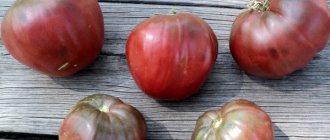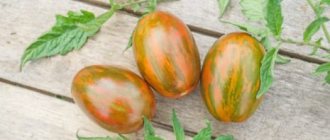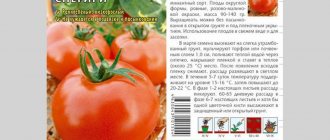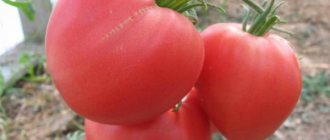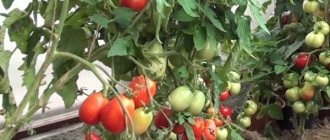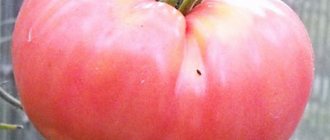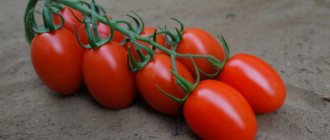The Siberian Miracle tomato is suitable for all lovers of fresh vegetables and delicious preserves. Its compact fruits are dense but not hard, have an excellent taste and are easy to use.
| Height | Landing location | Ripening time | Fruit color | Fruit size | Origin | Fruit shape |
| Tall | Greenhouse | Mid-early | Reds | Average | Variety | Plum-shaped or oval |
Characteristics and description of the variety
The Siberian Miracle variety was developed by Altai scientists. In 2006 it was included in the State Register.
The bush is indeterminate, standard, 1.3-1.5 m high (a little higher in the greenhouse). The stem is powerful, the foliage is large, emerald green. The inflorescences are simple.
Reference. An indeterminate bush does not stop growing.
The variety is mid-season - from the moment the first shoots appear to full ripening, 90-110 days pass. Fruiting is extended.
Productivity is high - from 1 sq. m harvest up to 13 kg, from 1 bush - 4-5 kg of fruit.
Due to his height, a garter is required. Not only the stem is tied up, but also the branches, despite their strength.
Culture needs stepsoning. It is formed into 2 stems, pruning regularly.
The Siberian miracle is characterized by increased resistance to tomato diseases. Well adapted to changes in weather conditions, does not stop either in growth or development.
The fruits are medium-sized, weighing 150-200 g, oval in shape, bright red in color with a crimson tint. The skin is smooth. The pulp is dense, moderately juicy. The taste is sweet, with a slightly noticeable sourness. There are 5-7 seed chambers. The fruits are not subject to cracking.
Tomatoes are universal in use. Suitable for pickles, pickles, marinades. They do not lose their taste when canning and making tomato products. Indispensable in summer salads and hot dishes.
The fruits are adapted for long-term storage and tolerate transportation well over short distances without loss of appearance and taste. For long-distance transportation, vegetables are harvested slightly unripe.
The photo shows Siberian Miracle tomatoes.
Subtleties of agricultural technology
The Siberian miracle tomato cannot be called capricious and overly whimsical. But a number of recommendations for caring for this mid-season, tall variety must be followed:
- The seedlings should be sufficiently mature at the time of planting. Its optimal age is two months.
- In a greenhouse, 3 bushes are placed per square meter, in a street bed - 4 bushes.
- Tall plants of the Siberian miracle require reliable garter and fixation.
- Pruning should be done regularly throughout the season. Both indoors and outdoors, bushes are grown with 1 or 2 stems.
- Complex feeding is necessary every week.
- Well-established ventilation increases the yield of the Siberian miracle in the greenhouse.
- The soil in the root zone should not dry out. Mulching helps maintain moderate humidity.
- To protect the Siberian Miracle tomato variety from diseases and harmful insects, the entire range of necessary measures is used: crop rotation or soil disinfection, preventive and therapeutic treatments.
The sonorous, declaring “Siberian” name does not impose restrictions on the region of cultivation. First of all, it is a sign of high quality. Tomatoes that perform well in the Siberian climate can grow anywhere.
How to grow seedlings
Sowing of seeds begins 60 days before planting seedlings in the ground.
The soil mixture is prepared from black soil, river sand, humus, peat and ash. All components are taken in equal proportions. Holes are made at the bottom of the planting containers and the prepared mixture is filled in half.
Before planting, seeds are disinfected in a weak solution of potassium permanganate, then washed with water. Dried grains are placed in the soil to a depth of 2 cm.
For planting, both a common box and disposable peat pots or plastic cups are suitable. When planting in individual containers, the sprouts do not need to be pricked afterwards.
The convenience of peat pots also lies in the fact that there is no need to replant seedlings from them. Peat pots themselves dissolve in the ground without harming the root system. The only downside is that this method of sowing seeds is more expensive than any other.
After sowing, the containers are left in a warm and dark place with an air temperature of 22-24°C.
When the first shoots appear, the seedlings are moved to a sunny windowsill, but not under direct sunlight. The soil is slightly moistened. Further watering is moderate; there is no need to over-moisten the soil, but the soil should not be allowed to dry out. After watering, the soil is loosened so that young roots develop better.
As the seedlings grow, the remaining soil is added to containers half filled with soil. This method provides the sprouts with new minerals and trace elements.
If the seedlings were planted in a common box, when two true leaves appear, they must be plucked and planted in separate containers. How to do this correctly, watch the video.
PICKING TOMATO SEEDLINGS
2 weeks before planting in the ground, seedlings begin to harden, taking them out into the open air for 2-3 hours. Gradually this time is increased to 12-14 hours. In the southern regions, this method is not called hardening, but the adaptation of sprouts to outdoor conditions.
Agricultural technology
Sowing seeds for seedlings is carried out approximately 2 months before the intended planting in a permanent place. After the formation of the first two true leaves, the seedlings are picked. Seedlings need to be planted in a permanent place when they are old enough.
In open ground, plants are planted in the amount of 4 pcs per 1 square meter, and when planted in a greenhouse - 3 pcs. After planting, the plants must be tied with special trellises so that the bush receives enough sunlight.
At the beginning of the formation of ovaries, plants need to be fed with potassium-phosphorus fertilizer. It is also recommended to use organic matter, which can be cow or bird droppings, wood ash and humus.
Watering is done no more than once every 3 days. In case of severe drought (if the tomatoes are planted in open ground), the frequency can be increased to 1 time every 2 days. Water for irrigation should be at room temperature.
During the growth process, regular loosening and weeding of the soil is important. If the soil has settled, it is necessary to hill up the bed and, if necessary, add soil.
It is important to observe some care features:
bushes are grown in 1-2 stems, and therefore regular pinching is necessary; Plants need to be fed every week; the greenhouse, especially in hot weather, must be ventilated; the soil should be mulched; It is important to regularly carry out disease prevention measures.
How to grow tomatoes
After 2 months, the sprouts are ready to be transplanted to a permanent location.
Beds for tomatoes are chosen in a sunny place, protected from drafts.
Planting pattern: 40 cm – distance between seedlings, 50 cm – between rows. For 1 sq. m there are 4 bushes.
The transplanted bushes are tied directly to the installed long supports. It is important that all plants receive the required amount of light, so installed supports should not shade them.
After transplanting, the holes are watered with warm, settled water, the soil is loosened and hilled up. Loosening and hilling promote the penetration of oxygen to the roots, which is necessary for full growth and development.
Regular watering is started as the seedlings become stronger. Water 2 times a week, only at the root and only with settled, non-cold water. In hot weather, the number of waterings is increased to 3-4 per week. After watering, the soil is loosened and weeds with roots are removed.
Mulching with straw retains moisture in the beds, due to which the soil does not dry out for a long time.
At the stage of ovary formation, bushes require fertilizing with a high content of phosphorus and potassium. This feeding is carried out 2 times. Throughout the entire growing season, tomatoes are fed once every 10 days with complex mineral fertilizers or organic matter. Mullein infusion, weed infusion and bird droppings are suitable as organics.
Important! The solution should not be highly concentrated, otherwise the root system will get burned. Dilution in a ratio of 1:15 will not harm the roots.
The bushes need pinching. They are pruned regularly, forming a plant with 2 stems. With this method, the highest fruiting rate is observed.
The initial garter of the bushes is carried out immediately upon transplantation. Then, as they grow and develop, the grown branches are tied up. Otherwise, the brushes will not withstand the weight of ripe fruits and will begin to creep along the ground, which will lead to rotting of the vegetables.
Diseases and pests
For the Siberian Miracle tomato, the main diseases of the nightshade family do not pose a danger. However, the crop can be attacked by brown rot and dry spotting.
Brown rot (another name is phomosis) is a fungal disease. It develops at high levels of humidity, so it is important to prevent the beds from becoming waterlogged. If affected by fungus, diseased ovaries must be destroyed and the bushes should be sprayed with Hom.
Dry spotting is also a fungal disease. It is often confused with late blight due to the similarity of symptoms. The leaves become covered with spots of various sizes, then the spots spread to the stem and fruits. The only difference from late blight is that the onset of the disease occurs in the early stages, which are not typical for late blight. Favorable factors for its development are a temperature of 25°C and high humidity (as for any other disease spread by spores). Systemic fungicides, for example, Quadris and Acrobat MC, are effective in combating it.
Among the pests you should be wary of are whiteflies and rust mites. Strong-smelling plants planted next to the tomato will help get rid of the butterfly.
As for the mite, it is a serious pest of any crop. The sucking parasite is spread by the wind and is so small that it is not easy to notice. The plant suffers greatly from its invasion, stops growing, the leaves turn brown and wither, the stem acquires a gray tint and becomes covered with cracks.
Among the folk methods of struggle, the use of infusions of garlic, horseradish, onion peels and wormwood is effective. If a tick has seriously occupied the beds, the drug “Zubr” will help drive it out. But do not forget that the use of insecticides in pest control is permissible only before fruit set.
Common diseases
The Siberian Miracle tomato is resistant to typical diseases and pests. Due to the short ripening period, the crop is not affected by late blight. Ensuring proper watering will prevent the development of blossom end, root and white rot. Regular ventilation of the greenhouse ensures the preservation of a favorable indoor microclimate.
Despite its strong immunity, the plant can be affected by Phoma. To get rid of the disease, all injured fruits should be removed and the plantings should be treated with Hom. Additionally, it is recommended to reduce the amount of watering and ensure the bushes are ventilated.
There are cases of bushes being affected by dry spotting. The drugs Tattu, Antrakol or Consento will help effectively fight the disease.
The nuances of growing in open ground and in a greenhouse
The variety has good adaptation both in open ground and in greenhouse conditions. The height of the bush in the greenhouse exceeds the growth of the seedling outside and reaches 1.7 m. In this case, the crown is pinched to limit growth.
In a greenhouse, the quantitative yield indicator is slightly higher: from 1 sq. m harvest up to 15 kg, and from 1 bush - up to 6 kg of vegetables. Crops planted in open beds give more modest results.
Growing in a greenhouse means less dense planting than outside. For 1 sq. m place 3 bushes.
When transplanting seedlings into open ground in cold regions, it does not hurt to stock up on some covering material. It will come in handy in case of unexpected cold weather or heavy rains.
Greenhouses require regular ventilation. This will help keep the plants healthy.
Conditions in which to grow
Description of the tomato variety Siberian Miracle indicates the culture’s resistance to stress factors. The plant is superior in resistance characteristics to most hybrids. Tomatoes retain the specificity of the variety even with changes in climatic conditions:
- do not stop growing and fully develop when the temperature drops;
- the flowering period and the formation of the fruit cluster occurs in any weather conditions;
- excellent yield when cultivated both in a greenhouse and in unprotected soil.
Culture resistance to stress factors
Reviews and photos of the Siberian Miracle tomato confirm the universal properties of the variety.
Harvesting and application
Fruit harvesting occurs in mid-August and continues until early September. Unripe vegetables are able to gain color on their own, and the taste is not inferior to those ripened in the garden beds.
Ripening occurs in waves, which allows the crop to be processed without loss. The earliest vegetables are usually larger. They are best used fresh.
The use of vegetables in cooking is universal. They are suitable for preparing fresh salads, hot vegetable dishes, and for canning. The small size allows you to place whole tomatoes in jars. They perfectly preserve their amazing taste in tomato juices and pastes; Well suited for making lecho, adjika, ketchup. Moreover, heat treatment of tomatoes only improves their taste. Ripe vegetables are also frozen and dried.
Tomatoes can be stored for a long time and can withstand transportation over short distances while maintaining their appearance and taste. Vegetables intended for long-distance transportation are advised to be collected unripe. The variety is suitable for cultivation for commercial purposes.
Advantages and disadvantages
The main advantage of Siberian varieties is their ability to take root in any climatic conditions and produce rich harvests. This feature is especially important in those regions where heat-loving crops grow poorly and bear little fruit.
Here are some more positive characteristics:
- high level of germination;
- disease resistance;
- formation of ovaries regardless of weather changes;
- ease of care;
- excellent taste of fruits;
- are not subject to cracking;
- wave-like ripening;
- versatility in application;
- long-term storage;
- possibility of transportation;
- cultivation for commercial purposes;
- independent selection of seeds for the next planting.
The negative aspects include:
- negative impact of waterlogged soil;
- Garter required;
- Regular stepsoning is required.
Farmer reviews
The review of this section will introduce the opinions of both experienced professionals and amateur summer residents. No one doubts the versatility of the variety. Those who have planted a Siberian crop at least once on their plot do not want to part with it and prepare seeds in advance for the next year.
Ekaterina, Kemerovo region: “Our climate is harsh, summer is short. Many varieties do not have time to ripen. My favorite tomato is a real miracle of Siberia, I’ve been planting it for 2 years. I have never regretted it. Both in winter and in summer with vegetables. The variety grows well and does not get sick.”
Galina, Perm region: “I planted it for the first time 5 years ago. The bushes are tall and strong. I tie it up and feed it three times a season. I give it to my stepson every week. I like the taste. I use it for salads and winter preparations. My favorite tomatoes."
Bush care
The bush of the “Miracle of the Market” variety is formed into 1-2 stems. All stepsons on the plant are removed, except the last one. The bushes are tied to a support or trellis. If during the growth process a large number of fruits are formed on the branches, they should be tied to a support or peg.
It is necessary to water the plants with warm water in the evening. During the season, tomatoes need to be fertilized with organic matter. Potassium phosphate complexes of mineral fertilizers can also be used for these purposes.
During the growth process, the bushes need the following care:
- Constant watering;
- Loosening the soil to enrich the root system of plants with oxygen;
- Fertilizing with organic matter and complex mineral fertilizers;
- Regular weeding.


